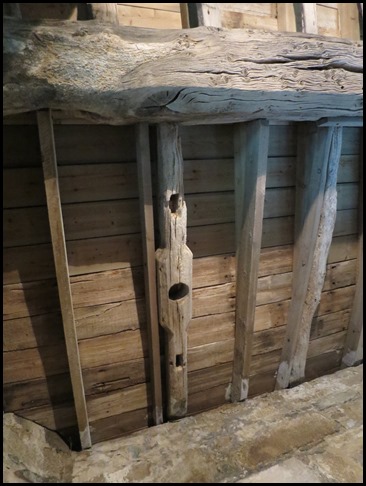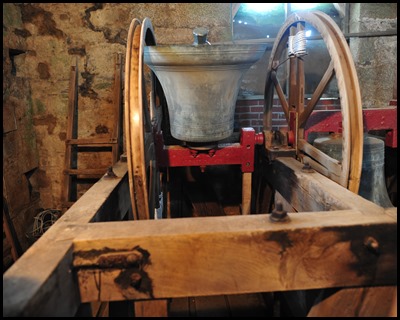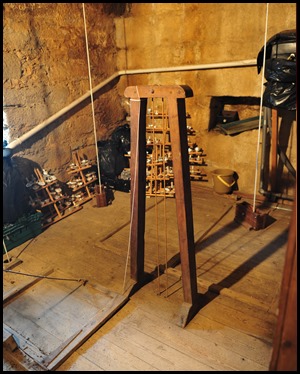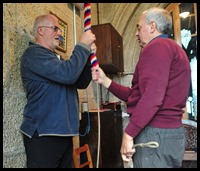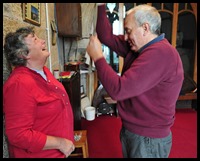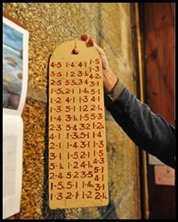The Bells of St Cleer

|
The History of the Bells of St Cleer Parish
Church
 After a bimble around the lovely
church Geoff led us up to the bell tower and introduced us to the six bells.
Copied from the Parish Church
Booklet, with kind thanks. There must have been bells at St Cleer since the
tower was built, but the only proof of this in ancient times is a quotation from
the Church Inventory of 1551 – “Seynt Cleer – its four belles hangynge yn theire
toure” written in E.H.W. Dunkin “Church Bells of Cornwall” 1878. More recently
there are the Churchwardens’ annual accounts from 1709 to the middle of the 19th
century with some interesting details.
There must still have been only four
bells in 1721, as the first mention of a bell was in that year when 500lbs of
mettle was purchased at a cost of twenty five pounds. Judging by the weight of
metal this must have been a new bell, possibly the predecessor of the present
2nd bell. There were also a lot of ancillary items that tend to confirm this
view. Twenty pounds was needed for “running the bells” – forty pounds for
hardwood – seventeen pence for a Bellstock, while fifty two pence was needed for
casting the brasses for four bells.
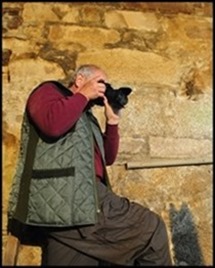  Up for a closer
look
In 1731 the names of Christopher
Pennington and Ambrose Gooding appear for the first time as Bellfounders. They
worked at Stoke, Stoke Climsland. The bill this time was for metal was only a
third of that referred to above, not enough for a new bell. Perhaps this was for
a recasting, but there is no reference as to which bell, and connected work was
only five pounds.
Vestry meetings were held annually to
appoint Churchwardens. The minutes of the year 1735 record a meeting called to
approve the casting of a new Treble bell. This motion was passed on the 5th of
December 1735, being signed by twenty one rate payers, including John Connock of
Treworgey.
The entry about this bell in 1735/36
is confusing as it refers to “the bells being nine pounds – six hundred and
eighty two and a half pounds at six pence per pound” – this weight was far more
than needed for a treble bell. In that year there
were entries for exchange of brasses, whips for the bells, carpentry for when
the bell was hung, and the costs of the Churchwardens when the bell was taken to
be weighed in Liskeard. In 1750 the Churchwardens
bargained with the bellfounder for casting the third bell and charged forty
pence for this: Ambrose Gooding charged fourteen pounds and eighty five pence
for casting the bell and brasses and “additional metal”. This must have been the
recasting of this bell. Up to this date we do not not know if the bells were
hung for full circle ringing; it is quite possible that they were not
used.
An old yoke
used as a support beam.
In 1789, there was a major operation.
According to E.H.W. Dunkin, all six bells were brought down and recast. The bill
from Penningtons, John and Christopher, was seventy five pounds and seventy five
pence – of which it was agreed that twenty pounds should be carried over till
the next year. There were also bills for timber and labour, four pounds and
forty five pence and one pound and thirty one pence, which presumably was for
the bell frame to enable them to be rung full circle; similar, but probably not
quite the same, as the present manner. Although all the bells were stamped IP:CP
1789, there could be some doubt about the fifth bell, clearly a rogue! It was
first mentioned in 1781 when a new clapper was needed. The accounts show this
bell was recast in 1793/94 for a total cost of thirteen pounds and eighty five
pence. Was the fifth bell, cast in 1789,recast again in 1793? However, even this
latter recasting was unsatisfactory as it had to be taken down and recast again
in 1805 – the Pennington bill was over twenty five pounds. In 1817, the founders
were paid a pound towards “keeping the fifth bell” for seven years! This did not
work, as in 1818 the bell again had to be recast, the bill for twenty five
pounds and seventy pence being paid over two years. to end this saga, the
present fifth bell was recast in 1845 by C. & G. Mears Foundry of London.
There was no mention of this in the accounts of that year, although Messrs.
Mears kindly sent copies of their accounts for the year 1845 showing that the
work was done through a Mr. Westcott, ironmonger of Plymouth. The cost of the
recasting was fifty six pounds and eighty five pence and a pound for a new
clapper. However, as they made an allowance of eight pounds and twenty nine
pence on the old bell, the total cost of nineteen pounds and fifty six pence
plus sixty two pence charges seems very modest – perhaps within the scope of a
generous donor? An amusing sideline to the great operation of 1789 is that the
“Keeper of the Bells” was not paid his annual salary as “the bells were down”!
This is as far as the Churchwardens’ accounts take the story.
 However, from the witness of the
bells themselves, the third bell was recast in 1877 by Gillet & Co. of
Croydon and marked VR Jubilee 1877. The second was recast by Harry Stokes, a
bell hanger from Woodbury, Exeter. The next recorded transaction was 1948/49,
with a faculty of the 9th of April 1948, when the bells were rehung with new
fittings, brasses and clappers.The bells were quarter turned and tuned. This was
carried out by John Taylor of Loughborough at a cost of eight hundred and twelve
pounds. The bells were rededicated on the 27th of February 1949. In 1967 the
bells were serviced by a Mr. Arthur Fidler, then working for the above firm.
In 1972 a ringing gallery was built,
raising the ringing position from ground level to a level eight feet up the
tower. This made ringing easier and, being closed, is warmer.
 Geoff has
been ringing here for twenty years and is incredibly knowledgeable.
In 1986, the same Mr. Arthur Fidler
from 1967, now a freelance Bellhanger, was invited to inspect, report and give
estimates. This he did, but no money was available at the time. The major part
of his estimates consisted of cleaning, clearing, wood treatment, de-rusting
etc. In 1988, both effort and money was available. Member of the Tower undertook
the “major part” as described above, while Mr.Fidler himself carried out the
technical aspects. The total cost was one thousand, six hundred and twenty eight
pounds, a great saving on the 1986 estimates of three thousand, four hundred and
seventy four pounds.
 2nd C
The bells.
Treble
D
4.3.10 IP:CP 1789
2nd
C
4.0.23 IP:CP
1789 Recast by Gillett & Johnson,
Croydon. 1900
3rd
Bb
5.1.10
Recast by Gillett and Co., Croydon V.R. Jubilee 1887
4th
A
5.3.4 IP:CP
1789 Peace and Good
Neighbourhood
5th
G
8.0.0
C. & G. Mears Foundry, London 1845
Tenor
F
10.0.12 IP:CP
1789 John Jope M.A.
|
